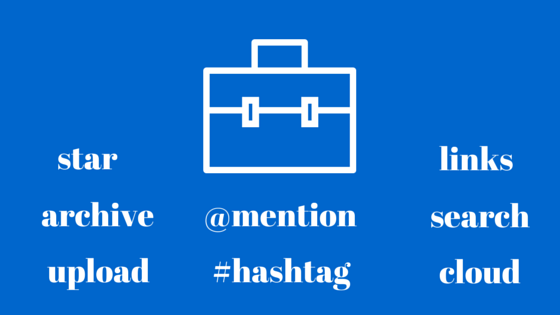The foundation of every relationship is built on trust and communication. Communicating well builds trust. Trust opens the doors of communication.
But how can you emphasize trust and communication in your organization? What tools support a culture of transparency and results?
A New Definition for Team Communication
If you're wondering what Slack is, the company website says it best:
Slack is a platform for team communication: everything in one place, instantly searchable, available wherever you go.
Put another way: Slack is the best of every communication medium combined in a beautiful design and intuitive interface that works across every major platform.
Because of the familiar features (hashtags, @mentions, emojis, links, favorites, etc) new users instantly feel at home and ramp up quickly.
Slack combines the core benefits of email, the reactive speed of text messaging, the accessibility of social networks, and the responsiveness of mobile to deliver a solution that looks simple on the surface while packing a powerful punch under the hood.
You get to make your individual Slack setup as complicated or clean as you want.
Essential Fundamentals
Communication within Slack is organized into 3 main categories:
- Channels
- Direct messages
- Private Groups
Channels are the primary streams of communication.
Think of them as topics or projects. Channels are open to anyone within the Slack group to join or review. This provides open dialogue, enables cross functional communication, and helps a team identify where multiple bodies of work may intersect.
For teams of any size it's important to manage the volume and scope of the channels.
A channel can get too crowded with overlapping dialogue. On the flip side, if a new channel is created for everything, it's difficult to keep track of the right conversation. Not to mention your notifications will go haywire.
In addition to a channel for each major project (topic, department, etc), here are a few standard channels every team should use:
- Resources. This serves as a repository for links, documents, photos, books, tools or whatever content can serve as a resource for helping your team get the work done well.
Random. If anyone on your team likes Dilbert, cat gifs, The Daily Show, or baby memes, this is the place to drop that stuff. A little humor goes a long way. Brainstorm. Teams are rich with ideas. Provide an easy place to pitch ideas and ask for feedback. They won't all be gems, but you'll never find a diamond if you don't start digging. HighLow. Remember your team is made up of human beings, not machines. This channel gives people the chance to be vulnerable and highlight a weekly/daily win as well as share a struggle. We all need hugs and high fives. Water Cooler. We can't upload or download cold beverages just yet, but casual conversation and shooting the breeze improves team cohesion and can lead to new ideas. Give your team a place where everyone can relax and chat about weekend plans or favorite bands. Questions. A team is a collective genius, but each individual is not an Einstein or Edison. No one knows everything and there are plenty of questions. Provide a safe place to ask questions without feeling dumb and praise people for taking the initiative to find answers and help each other.These six channels create a solid foundation to start using Slack like a pro right out of the gate.
The remaining communication options are pretty self-explanatory.
Direct messages. Communication between two team members that only they can see. Kind of like an email or instant message with no cc or bcc option.
Private group. Think of this is an exclusive channel. It functions the same, but the content is only visible to those included by the admin. Warning: use this sparingly. The goal is open, effective communication.
Building Your Toolbox
Slack has a ton of features to facilitate communication, information sharing, and project management.
- #hashtag. Just like Twitter, use hashtags within comments to tag a channel or specific topic. This helps organize search results and allows users to find relevant details easily. This comes in handy if a particular item has implications for multiple channels. Instead of posting the same content in 4 different places, just add the desired hashtag.
@mention. Most social media platforms allow you to @mention (or tag) someone in a post or photo. Within a Slack channel you can @mention a specific team member (@individual), the entire channel (@channel), or the whole team associated with a particular Slack account (@everyone). Using the @mention feature will specifically ping the applicable user via their personal notification settings (via email, mobile, or desktop). star. much like a "favorite" on Twitter ("like" on Facebook, "+1" on Google+), Slack allows you to "star" comments. This can simply be a method of showing support or agreement with a comment or you can use it to mark something for reference later. Just like hashtags, stars are integrated with the search function. upload. If you can attach it to an email, you can upload it to Slack. Graphics, images, spreadsheets, documents, etc. With dozens of app integrations you can even link Slack to your Google Drive or Dropbox folders for easy sharing and file management. links. Whether sharing a resource, requesting feedback, or looking at a preview of a new website, you can post a link and Slack will load a preview (just like Facebook). search. Data is only useful if you can find it. The same goes for communication. Looking for a file? Trying to remember what Bob said about that one proposal? Pop some simple terms in the native search bar at the top and the answers are at your fingertips. archive. All projects eventually come to an end. Slack enables users to archive channels and private groups. This allows teams to keep communication clear of clutter while still having the content available for later reference. cloud. Ever spilled coffee on your laptop? How about dropped your iPhone in the toilet? Or lost your iPad at the airport? No worries. Everything in Slack sits safely and securely in the cloud. You can access it from any platform or web browser.Conclusion
Too often organizations young and old resign themselves to archaic communication tools and face the daily frustration with agony.
You don't have time for that nonsense. Join Slack (for FREE) and discover the most dynamic, powerful, and user-friendly communication tool ever designed.
James Carbary is the founder of Sweet Fish Media. You don't have time to write and promote a blog for your business. Let Sweet Fish do it for you.
Wanna connect with James? You can find him on Twitter, LinkedIn, or send him an email.
Support HuffPost
Our 2024 Coverage Needs You
Your Loyalty Means The World To Us
At HuffPost, we believe that everyone needs high-quality journalism, but we understand that not everyone can afford to pay for expensive news subscriptions. That is why we are committed to providing deeply reported, carefully fact-checked news that is freely accessible to everyone.
Whether you come to HuffPost for updates on the 2024 presidential race, hard-hitting investigations into critical issues facing our country today, or trending stories that make you laugh, we appreciate you. The truth is, news costs money to produce, and we are proud that we have never put our stories behind an expensive paywall.
Would you join us to help keep our stories free for all? Your contribution of as little as $2 will go a long way.
Can't afford to donate? Support HuffPost by creating a free account and log in while you read.
As Americans head to the polls in 2024, the very future of our country is at stake. At HuffPost, we believe that a free press is critical to creating well-informed voters. That's why our journalism is free for everyone, even though other newsrooms retreat behind expensive paywalls.
Our journalists will continue to cover the twists and turns during this historic presidential election. With your help, we'll bring you hard-hitting investigations, well-researched analysis and timely takes you can't find elsewhere. Reporting in this current political climate is a responsibility we do not take lightly, and we thank you for your support.
Contribute as little as $2 to keep our news free for all.
Can't afford to donate? Support HuffPost by creating a free account and log in while you read.
Dear HuffPost Reader
Thank you for your past contribution to HuffPost. We are sincerely grateful for readers like you who help us ensure that we can keep our journalism free for everyone.
The stakes are high this year, and our 2024 coverage could use continued support. Would you consider becoming a regular HuffPost contributor?
Dear HuffPost Reader
Thank you for your past contribution to HuffPost. We are sincerely grateful for readers like you who help us ensure that we can keep our journalism free for everyone.
The stakes are high this year, and our 2024 coverage could use continued support. If circumstances have changed since you last contributed, we hope you’ll consider contributing to HuffPost once more.
Already contributed? Log in to hide these messages.



